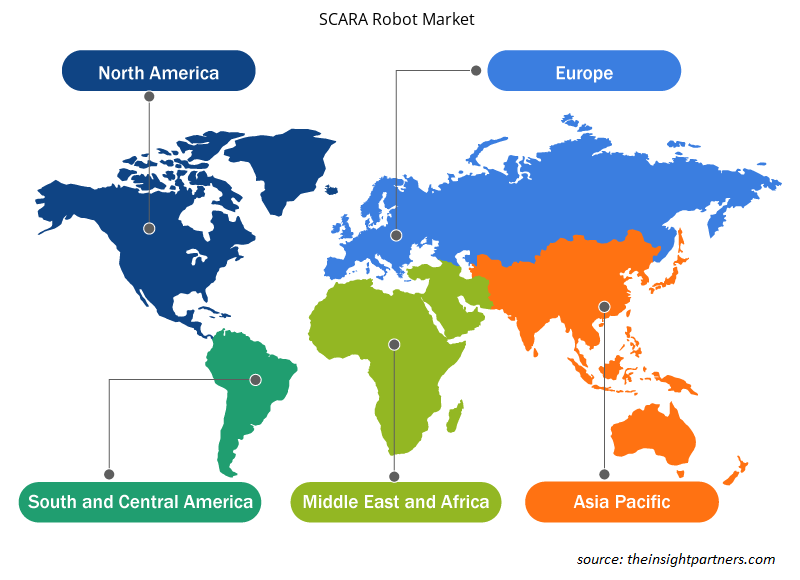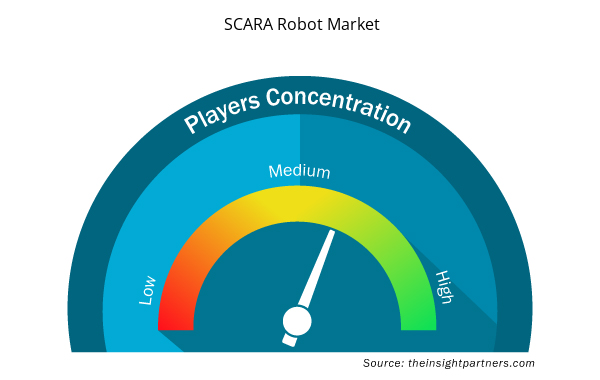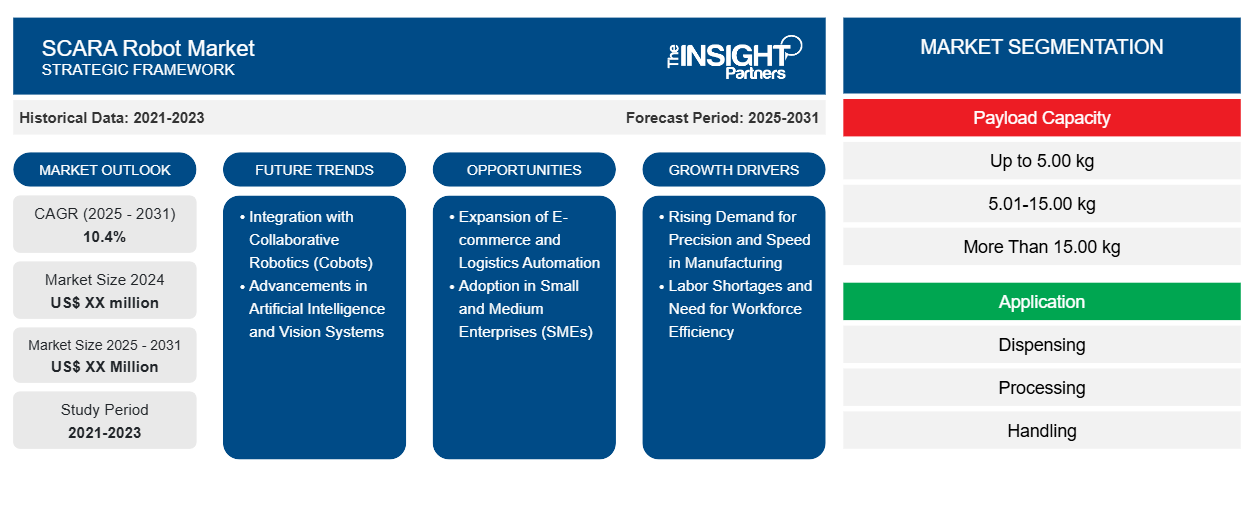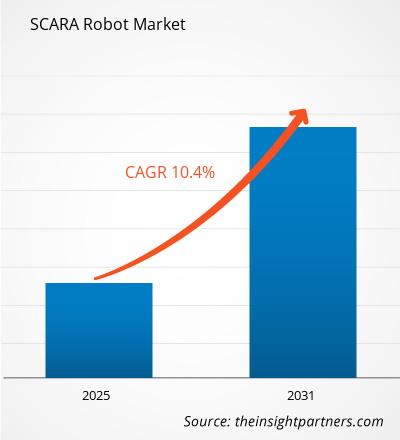Le marché des robots SCARA devrait enregistrer un TCAC de 10,4 % de 2023 à 2031, avec une taille de marché passant de XX millions USD en 2023 à XX millions USD d'ici 2031.
Le rapport est segmenté par capacité de charge utile (jusqu'à 5,00 kg, 5,01-15,00 kg, plus de 15,00 kg) ; application (distribution, traitement, manutention, assemblage et démontage, soudage et brasage, autres) ; secteur vertical (automobile, électricité et électronique, ingénierie de précision et optique, métaux et machines, alimentation et boissons, autres). L'analyse globale est ensuite décomposée au niveau régional et par principaux pays. Le rapport offre la valeur en USD pour l'analyse et les segments ci-dessus.
Objectif du rapport
Le rapport SCARA Robot Market de The Insight Partners vise à décrire le paysage actuel et la croissance future, les principaux facteurs moteurs, les défis et les opportunités. Cela fournira des informations à diverses parties prenantes commerciales, telles que :
- Fournisseurs/fabricants de technologie : pour comprendre l’évolution de la dynamique du marché et connaître les opportunités de croissance potentielles, leur permettant de prendre des décisions stratégiques éclairées.
- Investisseurs : Effectuer une analyse complète des tendances concernant le taux de croissance du marché, les projections financières du marché et les opportunités qui existent tout au long de la chaîne de valeur.
- Organismes de réglementation : Réglementer les politiques et surveiller les activités du marché dans le but de minimiser les abus, de préserver la confiance des investisseurs et de maintenir l’intégrité et la stabilité du marché.
Segmentation du marché des robots SCARA
Capacité de charge utile
- Jusqu'à 5,00 kg
- 5,01-15,00 kg
- Plus de 15,00 kg
Application
- Distribution
- Traitement
- Manutention
- Montage et démontage
- Soudure et brasure
- Autres
Secteur d'activité vertical
- Automobile
- Électricité et électronique
- Ingénierie de précision et optique
- Métaux et machines
- Alimentation et boissons
- Autres
Géographie
- Amérique du Nord
- Europe
- Asie-Pacifique
- Amérique du Sud et Amérique centrale
- Moyen-Orient et Afrique
Géographie
- Amérique du Nord
- Europe
- Asie-Pacifique
- Amérique du Sud et Amérique centrale
- Moyen-Orient et Afrique
Personnalisez ce rapport en fonction de vos besoins
Vous bénéficierez d'une personnalisation gratuite de n'importe quel rapport, y compris de certaines parties de ce rapport, d'une analyse au niveau des pays, d'un pack de données Excel, ainsi que d'offres et de remises exceptionnelles pour les start-ups et les universités.
- Obtenez les principales tendances clés du marché de ce rapport.Cet échantillon GRATUIT comprendra une analyse de données, allant des tendances du marché aux estimations et prévisions.
Facteurs de croissance du marché des robots SCARA
- Demande croissante de précision et de rapidité dans la fabrication : La demande croissante d'automatisation rapide, précise et rentable dans des secteurs tels que l'électronique, l'automobile et les biens de consommation est un facteur majeur pour le marché des robots SCARA (Selective Compliance Assembly Robot Arm). Les robots SCARA sont connus pour leur capacité à effectuer des tâches à grande vitesse et avec précision, en particulier dans les applications d'assemblage, de pick-and-place et d'emballage. Leur conception, qui permet un mouvement sur deux axes horizontaux, permet des opérations rapides et précises, ce qui les rend idéaux pour les industries qui cherchent à améliorer l'efficacité de la production et à réduire les coûts de main-d'œuvre.
- Pénurie de main-d’œuvre et besoin d’efficacité de la main-d’œuvre : Alors que la pénurie de main-d’œuvre continue de toucher de nombreux secteurs manufacturiers, les entreprises se tournent de plus en plus vers l’automatisation pour maintenir leurs niveaux de productivité. Les robots SCARA, qui sont relativement simples à déployer, à entretenir et à programmer par rapport aux autres systèmes robotiques, offrent aux fabricants une solution efficace pour répondre à cette demande. Ces robots contribuent à combler le vide laissé par les travailleurs humains, en effectuant des tâches répétitives et chronophages tout en améliorant la cohérence et la qualité des produits, ce qui en fait une option attrayante pour relever les défis de la main-d’œuvre.
Tendances futures du marché des robots SCARA
- Intégration avec la robotique collaborative (cobots) : la tendance à intégrer les robots SCARA à la robotique collaborative (cobots) gagne du terrain. Les cobots sont conçus pour travailler aux côtés des opérateurs humains dans des espaces de travail partagés, améliorant ainsi la productivité et la sécurité. Les robots SCARA, avec leurs mouvements précis et leur conception légère, sont adaptés pour travailler aux côtés des travailleurs humains pour des tâches telles que l'assemblage, l'inspection et l'emballage. Cette intégration permet aux entreprises de déployer des robots SCARA dans des environnements où la flexibilité et la sécurité sont primordiales, comme la fabrication électronique ou la production en petites séries.
- Progrès dans les systèmes d'intelligence artificielle et de vision : les robots SCARA sont de plus en plus intégrés à l'intelligence artificielle (IA) et aux systèmes de vision artificielle pour améliorer leurs capacités. L'IA permet aux robots d'apprendre de leur environnement et de prendre des décisions en temps réel, améliorant ainsi leur capacité à gérer des tâches complexes, à s'adapter aux changements et à améliorer la précision. Les systèmes de vision artificielle, associés à l'IA, permettent aux robots SCARA d'effectuer des contrôles de qualité, des détections d'erreurs et l'identification des pièces avec une grande précision. Ces avancées rendent les robots SCARA plus polyvalents et plus performants, élargissant leur utilisation dans des secteurs tels que l'assemblage électronique, la fabrication de dispositifs médicaux et le contrôle qualité.
Opportunités de marché pour les robots SCARA
- Expansion du commerce électronique et de l'automatisation de la logistique : La croissance rapide du commerce électronique et la complexité croissante des opérations logistiques créent une opportunité importante pour les robots SCARA. Ces robots sont très efficaces dans les tâches de manutention, de tri, d'emballage et d'exécution des commandes, ce qui en fait un choix naturel pour les centres de distribution, les entrepôts et les opérations d'exécution du commerce électronique. À mesure que le commerce électronique continue de croître, la demande de robots SCARA pour automatiser des processus clés tels que le tri, l'emballage et la gestion des stocks devrait augmenter, ce qui entraînera une nouvelle expansion du marché.
- Adoption dans les petites et moyennes entreprises (PME) : les robots SCARA offrent une solution d'automatisation rentable, ce qui en fait un choix idéal pour les petites et moyennes entreprises (PME) qui souhaitent mettre en œuvre l'automatisation sans l'investissement en capital élevé généralement requis pour d'autres systèmes robotiques. Avec leur coût relativement faible, leur facilité de programmation et leur polyvalence, les robots SCARA deviennent de plus en plus accessibles aux PME de divers secteurs tels que l'automobile, l'électronique et les biens de consommation. L'accessibilité et la disponibilité croissantes des robots SCARA présentent une forte opportunité de croissance pour le marché du segment des PME.
Aperçu régional du marché des robots SCARA
Les tendances et facteurs régionaux influençant le marché des robots SCARA tout au long de la période de prévision ont été expliqués en détail par les analystes d’Insight Partners. Cette section traite également des segments et de la géographie du marché des robots SCARA en Amérique du Nord, en Europe, en Asie-Pacifique, au Moyen-Orient et en Afrique, ainsi qu’en Amérique du Sud et en Amérique centrale.

- Obtenez les données régionales spécifiques au marché des robots SCARA
Portée du rapport sur le marché des robots SCARA
| Attribut de rapport | Détails |
|---|---|
| Taille du marché en 2023 | XX millions de dollars américains |
| Taille du marché d'ici 2031 | XX millions de dollars américains |
| Taux de croissance annuel composé mondial (2023-2031) | 10,4% |
| Données historiques | 2021-2022 |
| Période de prévision | 2024-2031 |
| Segments couverts | Par capacité de charge utile
|
| Régions et pays couverts | Amérique du Nord
|
| Leaders du marché et profils d'entreprises clés |
|
Densité des acteurs du marché des robots SCARA : comprendre son impact sur la dynamique commerciale
Le marché des robots SCARA connaît une croissance rapide, tirée par la demande croissante des utilisateurs finaux en raison de facteurs tels que l'évolution des préférences des consommateurs, les avancées technologiques et une plus grande sensibilisation aux avantages du produit. À mesure que la demande augmente, les entreprises élargissent leurs offres, innovent pour répondre aux besoins des consommateurs et capitalisent sur les tendances émergentes, ce qui alimente davantage la croissance du marché.
La densité des acteurs du marché fait référence à la répartition des entreprises ou des sociétés opérant sur un marché ou un secteur particulier. Elle indique le nombre de concurrents (acteurs du marché) présents sur un marché donné par rapport à sa taille ou à sa valeur marchande totale.
Les principales entreprises opérant sur le marché des robots SCARA sont :
- ABB Ltée.
- Comau SpA
- Société DENSO
- Fanuc Corp
- Kawasaki Heavy Industries, Ltée.
Avis de non-responsabilité : les sociétés répertoriées ci-dessus ne sont pas classées dans un ordre particulier.

- Obtenez un aperçu des principaux acteurs du marché des robots SCARA
Principaux arguments de vente
- Couverture complète : Le rapport couvre de manière exhaustive l’analyse des produits, des services, des types et des utilisateurs finaux du marché des robots SCARA, offrant un paysage holistique.
- Analyse d’experts : Le rapport est compilé sur la base d’une compréhension approfondie des experts et analystes du secteur.
- Informations à jour : Le rapport garantit la pertinence commerciale en raison de sa couverture des informations récentes et des tendances des données.
- Options de personnalisation : ce rapport peut être personnalisé pour répondre aux exigences spécifiques du client et s'adapter parfaitement aux stratégies commerciales.
Le rapport de recherche sur le marché des robots SCARA peut donc aider à ouvrir la voie au décodage et à la compréhension du scénario de l’industrie et des perspectives de croissance. Bien qu’il puisse y avoir quelques préoccupations valables, les avantages globaux de ce rapport ont tendance à l’emporter sur les inconvénients.
- Analyse historique (2 ans), année de base, prévision (7 ans) avec TCAC
- Analyse PEST et SWO
- Taille du marché Valeur / Volume - Mondial, Régional, Pays
- Industrie et paysage concurrentiel
- Ensemble de données Excel



Report Coverage
Revenue forecast, Company Analysis, Industry landscape, Growth factors, and Trends

Segment Covered
This text is related
to segments covered.

Regional Scope
North America, Europe, Asia Pacific, Middle East & Africa, South & Central America

Country Scope
This text is related
to country scope.
Questions fréquemment posées
Some of the customization options available based on the request are an additional 3-5 company profiles and country-specific analysis of 3-5 countries of your choice. Customizations are to be requested/discussed before making final order confirmation# as our team would review the same and check the feasibility
The report can be delivered in PDF/PPT format; we can also share excel dataset based on the request
The major factors driving the SCARA Robot market are Rising Demand for Mass Production and Rising Labor Costs.
The trend towards Industry 4.0 and the development of smart factories are also significant factors which is anticipated to play a significant role in the global SCARA Robot market in the coming years
The SCARA Robot Market is estimated to witness a CAGR of 10.4% from 2023 to 2031
-
Trends and growth analysis reports related to Electronics and Semiconductor : READ MORE..
1. ABB Ltd.
2. Comau SpA
3. DENSO Corporation
4. Fanuc Corp
5. Kawasaki Heavy Industries, Ltd.
6. KUKA AG
7. Seiko Epson Corporation
8. Staubli International AG
9. Toshiba Machine Co., Ltd.
10. Yamaha Motor Co., Ltd.
The Insight Partners performs research in 4 major stages: Data Collection & Secondary Research, Primary Research, Data Analysis and Data Triangulation & Final Review.
- Data Collection and Secondary Research:
As a market research and consulting firm operating from a decade, we have published and advised several client across the globe. First step for any study will start with an assessment of currently available data and insights from existing reports. Further, historical and current market information is collected from Investor Presentations, Annual Reports, SEC Filings, etc., and other information related to company’s performance and market positioning are gathered from Paid Databases (Factiva, Hoovers, and Reuters) and various other publications available in public domain.
Several associations trade associates, technical forums, institutes, societies and organization are accessed to gain technical as well as market related insights through their publications such as research papers, blogs and press releases related to the studies are referred to get cues about the market. Further, white papers, journals, magazines, and other news articles published in last 3 years are scrutinized and analyzed to understand the current market trends.
- Primary Research:
The primarily interview analysis comprise of data obtained from industry participants interview and answers to survey questions gathered by in-house primary team.
For primary research, interviews are conducted with industry experts/CEOs/Marketing Managers/VPs/Subject Matter Experts from both demand and supply side to get a 360-degree view of the market. The primary team conducts several interviews based on the complexity of the markets to understand the various market trends and dynamics which makes research more credible and precise.
A typical research interview fulfils the following functions:
- Provides first-hand information on the market size, market trends, growth trends, competitive landscape, and outlook
- Validates and strengthens in-house secondary research findings
- Develops the analysis team’s expertise and market understanding
Primary research involves email interactions and telephone interviews for each market, category, segment, and sub-segment across geographies. The participants who typically take part in such a process include, but are not limited to:
- Industry participants: VPs, business development managers, market intelligence managers and national sales managers
- Outside experts: Valuation experts, research analysts and key opinion leaders specializing in the electronics and semiconductor industry.
Below is the breakup of our primary respondents by company, designation, and region:

Once we receive the confirmation from primary research sources or primary respondents, we finalize the base year market estimation and forecast the data as per the macroeconomic and microeconomic factors assessed during data collection.
- Data Analysis:
Once data is validated through both secondary as well as primary respondents, we finalize the market estimations by hypothesis formulation and factor analysis at regional and country level.
- Macro-Economic Factor Analysis:
We analyse macroeconomic indicators such the gross domestic product (GDP), increase in the demand for goods and services across industries, technological advancement, regional economic growth, governmental policies, the influence of COVID-19, PEST analysis, and other aspects. This analysis aids in setting benchmarks for various nations/regions and approximating market splits. Additionally, the general trend of the aforementioned components aid in determining the market's development possibilities.
- Country Level Data:
Various factors that are especially aligned to the country are taken into account to determine the market size for a certain area and country, including the presence of vendors, such as headquarters and offices, the country's GDP, demand patterns, and industry growth. To comprehend the market dynamics for the nation, a number of growth variables, inhibitors, application areas, and current market trends are researched. The aforementioned elements aid in determining the country's overall market's growth potential.
- Company Profile:
The “Table of Contents” is formulated by listing and analyzing more than 25 - 30 companies operating in the market ecosystem across geographies. However, we profile only 10 companies as a standard practice in our syndicate reports. These 10 companies comprise leading, emerging, and regional players. Nonetheless, our analysis is not restricted to the 10 listed companies, we also analyze other companies present in the market to develop a holistic view and understand the prevailing trends. The “Company Profiles” section in the report covers key facts, business description, products & services, financial information, SWOT analysis, and key developments. The financial information presented is extracted from the annual reports and official documents of the publicly listed companies. Upon collecting the information for the sections of respective companies, we verify them via various primary sources and then compile the data in respective company profiles. The company level information helps us in deriving the base number as well as in forecasting the market size.
- Developing Base Number:
Aggregation of sales statistics (2020-2022) and macro-economic factor, and other secondary and primary research insights are utilized to arrive at base number and related market shares for 2022. The data gaps are identified in this step and relevant market data is analyzed, collected from paid primary interviews or databases. On finalizing the base year market size, forecasts are developed on the basis of macro-economic, industry and market growth factors and company level analysis.
- Data Triangulation and Final Review:
The market findings and base year market size calculations are validated from supply as well as demand side. Demand side validations are based on macro-economic factor analysis and benchmarks for respective regions and countries. In case of supply side validations, revenues of major companies are estimated (in case not available) based on industry benchmark, approximate number of employees, product portfolio, and primary interviews revenues are gathered. Further revenue from target product/service segment is assessed to avoid overshooting of market statistics. In case of heavy deviations between supply and demand side values, all thes steps are repeated to achieve synchronization.
We follow an iterative model, wherein we share our research findings with Subject Matter Experts (SME’s) and Key Opinion Leaders (KOLs) until consensus view of the market is not formulated – this model negates any drastic deviation in the opinions of experts. Only validated and universally acceptable research findings are quoted in our reports.
We have important check points that we use to validate our research findings – which we call – data triangulation, where we validate the information, we generate from secondary sources with primary interviews and then we re-validate with our internal data bases and Subject matter experts. This comprehensive model enables us to deliver high quality, reliable data in shortest possible time.


 Obtenez un échantillon gratuit pour ce rapport
Obtenez un échantillon gratuit pour ce rapport